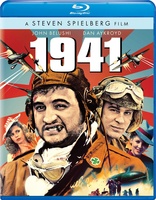1941 Blu-ray Movie
Home1941 Blu-ray Movie 
Universal Studios | 1979 | 1 Movie, 2 Cuts | 146 min | Not rated | May 05, 2015Movie rating
6.3 | / 10 |
Blu-ray rating
| Users | 3.9 | |
| Reviewer | 4.0 | |
| Overall | 3.9 |
Overview
1941 (1979)
After the bombing of Pearl Harbor, mass hysteria breaks out in Southern California, while the bumbling crew of a Japanese sub searches for Hollywood and an "honorable" target to destroy.
Starring: Dan Aykroyd, Ned Beatty, John Belushi, Lorraine Gary, Murray HamiltonDirector: Steven Spielberg
| War | Uncertain |
| Comedy | Uncertain |
Specifications
Video
Video codec: MPEG-4 AVC
Video resolution: 1080p
Aspect ratio: 2.35:1
Original aspect ratio: 2.39:1
Audio
English: DTS-HD Master Audio 5.1 (48kHz, 24-bit)
Subtitles
English SDH, French, Spanish
Discs
50GB Blu-ray Disc
Single disc (1 BD)
Playback
Region free
Review
Rating summary
| Movie | 3.0 | |
| Video | 4.0 | |
| Audio | 4.0 | |
| Extras | 4.5 | |
| Overall | 4.0 |
1941 Blu-ray Movie Review
. . . And the Kitchen Sink
Reviewed by Michael Reuben October 23, 20141941 is unique in Steven Spielberg's filmography and possibly in the history of movies. Spielberg directed the film, but it isn't really "his". It's like the ball gown in Walt Disney's Sleeping Beauty that becomes the object of two stubborn fairies fighting over the color ("Pink!" "Blue!") until their competing spells create something that's a hodgepodge. In the 1996 documentary, "The Making of 1941", co-writer Robert Zemeckis, who was known at the time as one half of "the Two Bobs" for his partnership with Bob Gale, observes that, if he had directed the film, it would have been a dark satire, but that Spielberg wanted to make a screwball comedy. Spielberg himself says that he took on the script because he had nothing else planned after Close Encounters of the Third Kind, and he liked its crazy spirit, even after his friend John Wayne refused a part in the movie and told Spielberg it was "un-American". Meanwhile, co-writer and executive producer John Milius, who was shepherding the project with his new-found clout after the success of The Wind and the Lion, sprinkled his personal brand of anarchic gunpowder over the project wherever he could. The result of these various temperaments who made each other laugh, but didn't necessarily mesh creatively, was a film all of them loved, but the executives at Universal and Columbia (who were co-producing) hated. So did U.S. audiences. In Europe, though, viewers seemed to share the filmmakers' point of view—a point that Spielberg cites with pride in "The Making of 1941", thereby inadvertently sounding like the punchline to a comedy routine. (Maybe that's where Woody Allen got the idea for the conclusion to Hollywood Ending, his film about a director suffering from a psychosomatic case of blindness.) This is not to say that 1941 is a bad movie. It exists in its own self-created world where questions of good and bad no longer apply. When I first saw the film in 1979, I was one of those audience members that Spielberg describes in the documentary, who sat in the theater with their hands covering their ears (and wondering to myself, "Is this a different guy named Spielberg?"). But 1941 has grown on me in the decades since that first encounter, in part because it is so unapologetically juvenile. If you can dial into its wavelength, it's an experience like no other.
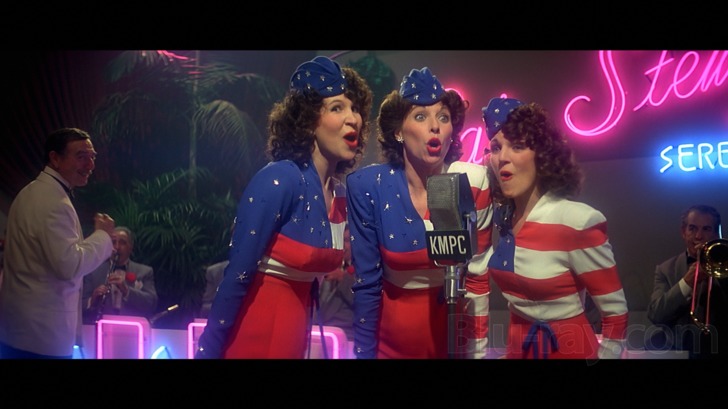
(Note: 1941 is included on Blu-ray in both its 119-minute theatrical version and the 146-minute extended cut that first appeared on Universal's 1996 Signature Laserdisc. The longer version restores many individual scenes that are both good in themselves and help connect the film's "plot", to the extent it has one. But the basic story and the major sequences are identical in both versions and the discussion below applies to both.) An opening text crawl informs the viewer that 1941 is set immediately following the Japanese bombing of Pearl Harbor, when citizens of the California coast feared (legitimately so) that their cities might be the next target. Now, if that doesn't immediately alert you that this is a film with no respect for the most sacred of cows, Spielberg provides another warning by parodying his own famous opening of Jaws, using the very same actress (Susan Backlinie) who played the shark's first victim. From that point forward, anything goes (a phrase, and Cole Porter song, that Spielberg says in the documentary kept running through his head during production, many years before he used it to open Indiana Jones and the Temple of Doom). 1941 switches among several comic focal points that gradually converge. One of them is a stray Japanese submarine that surfaces off the coast of San Francisco and is determined to destroy a major target so that it can return home with honor. Its commander, Mitamura, is played by the legendary Toshiro Mifune, sending up every samurai he's ever portrayed as he barks orders at his fumbling crew and bickers with his condescending Nazi "observer", Capt. von Kleinschmidt, who is played by Christopher Lee speaking fluent German. Deciding that Hollywood would be a suitable target but unsure of the way, Mitamura sends a landing party to kidnap a civilian for directions. When they bring back a farmer named "Hollis Wood" (can you hear the setup?) played by Slim Pickens, Spielberg can't resist a reference to Dr. Strangelove. In their beachfront home in Santa Monica, the Douglas family, Ward and Joan (Ned Beatty and Lorraine Gary, who played Roy Scheider's wife in Jaws), prepare for both Christmas and civil defense. Daughter Betty (Dianne Kay) and her friend Maxine (Wendie Jo Sperber) are attending a USO dance that evening, despite the objections of Betty's boyfriend, Wally (Bobby Di Cicco), who has been practicing his dance steps for months in anticipation of this night. But the dance is now closed to all but servicemen, a development of great satisfaction to a certain Cpl. Sitarski, nicknamed "Stretch" (Treat Williams), who set his sights on Betty when he participated in a crew stowing heavy ordinance at the Douglas home. The rivalry between Wally and the hot-tempered Stretch runs throughout the film, and it is complicated by the fact that Maxine, who is a bulldog in pursuing what she wants, has decided that she wants Stretch for herself. Their four-way chase transforms the USO's jitterbug contest into a carnival of acrobatics, followed by a brawl among servicemen, during which the harried M.C. (Joe Flaherty) provides live radio commentary of increasing desperation. Stretch's unit is commanded by Sgt. Frank Tree (Dan Ackroyd), who hasn't much experience with heavy weaponry, but can recite manuals from memory with machine gun speed. (His real experience is in the motor pool.) Sgt. Tree appears in downtown L.A. commanding a tank, but when he ends up incapacitated by a blow to the head, someone less military takes over, and the tank goes on a wild ride. (I remember realizing, when I first saw the tank burst through the walls of a paint factory and plow through one brightly colored vat after another, that Spielberg was staging these crazy slapstick scenes simply because he could.) Sgt. Tree's unit also contains a racist white private played by John Candy and a won't-take-no-nonsense black private played by Frank McCrae, thereby upping the film's political incorrectness quotient even further. A relative voice of sanity is provided by the commander of the armed forces for Southern California, Maj. Gen. Joseph W. Stilwell (Robert Stack), a real historical figure, though not as he's portrayed here. Gen. Stilwell thinks everyone should calm down, especially Col. "Madman" Maddox, who keeps sending in wild reports from his desert base in Barstow about secret Japanese installations in the surrounding hills. The general would rather relax by taking in a show of Walt Disney's Dumbo (it literally brings tears to his eyes), but his assistant, Capt. Loomis Birkhead (Tim Matheson), volunteers to visit Maddox in the desert, mostly because he wants to get the general's comely assistant, Donna Stratton (Nancy Allen), airborne in one of Maddox's planes. Ms. Stratton's particular quirk is that she only gets aroused while flying, and Loomis's plan almost succeeds, except that their flight isn't officially logged, so that the Interceptor Commander for Los Angeles (a cameo by director Sam Fuller) declares it a hostile target. Perhaps the single most memorable character in all of 1941 is John Belushi's Capt. Wild Bill Kelso, called by Gen. Stilwell "the craziest son of a bitch I've ever seen". Swooping in and out of the film, Kelso claims to be tracking a squadron of Japanese "zeros" that always seem to elude him—that is, until he spots the primitive "trainer" in which Loomis Birkhead is desperately trying to seduce Donna Stratton. The result is an aerial battle over the streets of Los Angeles that is one of the finest examples of pre-CGI special effects ever put on film. (The process is discussed at length in the extras.) Its only equal is the sequence immediately following, where Capt. Mitamura's sub finally surfaces near Hollywood and mistakes the ferris wheel near Santa Monica for an "industrial structure", on which it immediately commences firing. The two hapless observers sitting at the top (Murray Hamilton and Eddie Deezen)—or three, if you count the ventrilouqist's dummy—can only watch in horror. And why roll the ferris wheel down the Santa Monica pier, wrecking both in the process? Because they could.
1941 Blu-ray Movie, Video Quality 
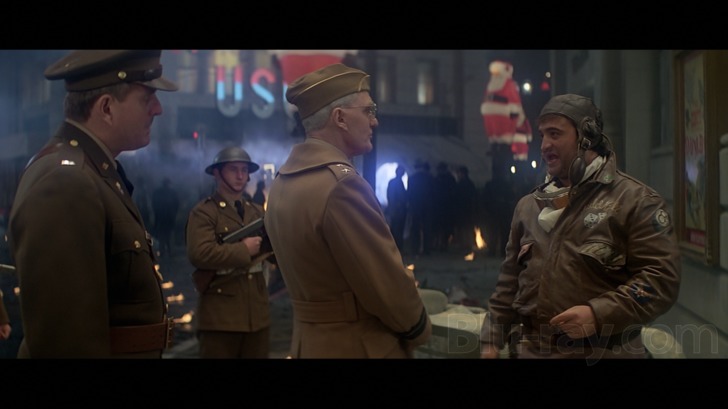
1941 was shot by veteran cinematographer William A. Fraker, who discusses the technical challenges of the massive shoot in "The Making of 1941". Probably the single biggest challenge for the film's cinematography was blending live-action footage with miniatures in a manner that looked convincing, a process that Spielberg also addresses in discussing the explosions intended to simulate the impact of the Japanese submarine's artillery shells. Smoke was a critical element in many of the miniature shots, which is one of the reasons why many of 1941's nighttime scenes are filled with fog, smoke and diffusion, all of which creates a challenge for any transfer to video. Previous versions of 1941 have suffered from poorly resolved grain and a variety of artifacts. Universal's 1080p, AVC-encoded Blu-ray of 1941 offers a massive improvement over previous home video presentations, though not without some digital tinkering. The graininess is largely gone. Although grain is certainly visible, more so in some scenes than others, it has been largely tamed by what appears to my eye to be the application of sophisticated de-graining software of the kind now commonly used in digital intermediate suites. Note that I am not talking about the kind of detail stripping that is typically meant by "DNR". The image remains detailed and sharp, except in scenes where it shouldn't be (e.g., the many scenes on the deck of the surfaced Japanese sub, which are shrouded in fog). I did not detect any effort to simulate detail with artificial sharpening, which would most likely have coarsened the grain. Overall, Universal appears to have reined in their past tendency to transform film into video, while still managing to clean up a challenging film for modern tastes. Purists (including myself) may have wished for a more authentically grainy presentation, but this one isn't bad. The colors are superb, ranging from the dingy interiors of the Japanese sub to the eye-popping primaries of the USO dance hall (and everything in between). Solid blacks are essential to the effective presentation of effects man A.D. Flowers' wonderful miniatures, and the disc provides them. Measured by the longer extended cut, Universal has mastered 1941 with an average bitrate of 27.18 Mbps, and it needs all of it. It should be noted that the extended cut has retained the opening disclaimer from the Signature Laserdisc stating that frame jumps may be observed where scenes were reinserted. That was true on the laserdisc, but those jumps appear to have been digitally mended for Blu-ray. Either that, or I was too absorbed in the film. (If anyone spots these, please send me a time mark, and I will update the review.)
1941 Blu-ray Movie, Audio Quality 
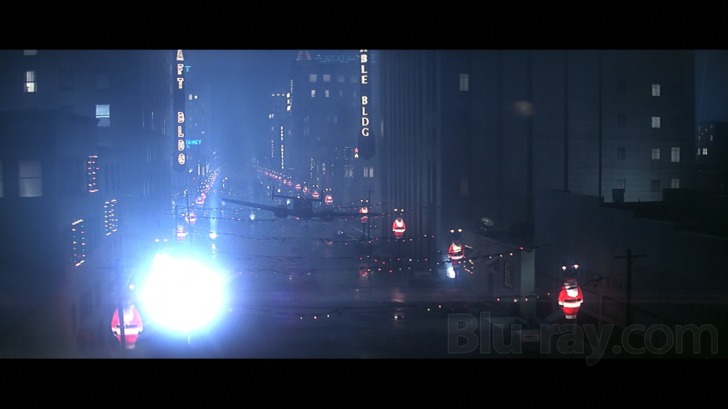
1941 was released in both stereo and a six-track mix for a 70mm blow-up. The Signature Laserdisc used the stereo mix, but the DVD had a 5.1 mix in Dolby Digital, which is encoded here in lossless DTS-HD MA. I cannot be certain whether this mix was derived from the 70mm version or represents a remix of the stereo, but I suspect the latter, because the additional footage in the extended version would have required a new 5.1 track in any case. The extended version still carries the disclaimer from the Signature Laserdisc cautioning that some lines of dialogue were distorted in the original recording and that sound effects have been "enhanced to take advantage of the improved dynamic range of today's home theater technology". However, the soundtrack of 1941 is so perpetually busy that I doubt that anyone except the original sound team could pick out the differences. Times have changed, though. Viewers accustomed to the sonic assault of, say, a Transformers film will wonder why anyone complained about 1941 when it was released in 1979. The film's 5.1 remix is sufficiently conservative not to attempt to re-route sound effects all around the listening space, where they would no doubt be placed if the film were made today. Nevertheless, the aerial sequences, cannon fire and machine gun used by Sgt. Tree have sufficient punch and bass extension to make themselves felt, especially with contemporary home theater equipment. The dialogue can be slightly hollow and tinny at times, but it's always intelligible. John Williams' score, which has a great martial theme that could almost be taken seriously, has been reproduced with fine fidelity, and it is a critical element in lassoing the onscreen chaos and keeping it from running wild.
1941 Blu-ray Movie, Special Features and Extras 
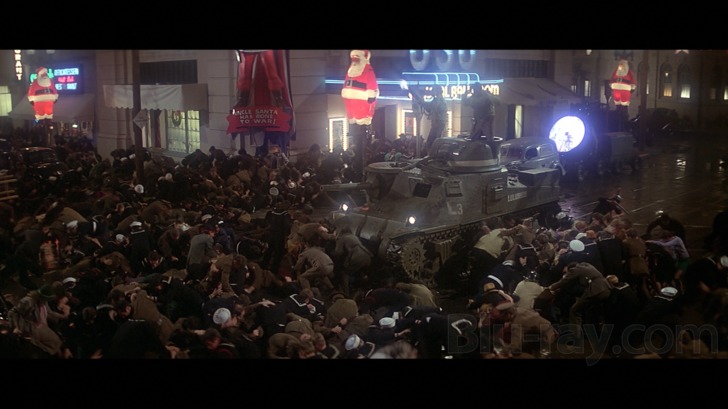
The extras for 1941 were first created for Universal's 1996 "Signature Laserdisc" edition, which was the studio's premium LD series. I do not own the "Collector's Edition" DVD released by Universal in 1999, but it appears from the cover art to have contained nearly all of the extras from the Signature LD. Most of these extras have been ported over to Blu-ray, with several key omissions, notably the isolated music track and substantial portions of what the Signature LD called "The 1941 Archives". As compensation, though, one receives the theatrical cut of the film in addition to its extended cut. The DVD and Signature LD offered only the extended cut.
- The Making of 1941 (480i; 1.33:1; 1:41:11): This feature-length documentary offers a frank and detailed overview of the making of 1941, directly from the creators themselves. The listing below is taken from the insert of the Signature LD, which is more detailed than the Blu-ray menu. A "play all" feature is included:
- Introduction by Steven Spielberg
- In the Beginning . . .
- John Milius
- Robert Zemeckis
- Bob Gale
- Based on Real-Life Events
- Bob Gale
- Setting Up the Project
- Bob Gale
- Steven Spielberg
- Collaboration
- Steven Spielberg
- Robert Zemeckis
- Bob Gale
- Michael Kahn
- Script Changes
- Bob Gale
- Casting
- John Milius
- Bob Gale
- Robert Zemeckis
- Steven Spielberg
- "Once That Movie Started . . . "
- John Milius
- Steven Spielberg
- Robert Zemeckis
- Inside Jokes
- Steven Spielberg
- Dance at the U.S.O.
- Steven Spielberg
- John Williams
- William A. Fraker
- The Louma Crane
- William A. Fraker
- Steven Spielberg's Home Movies
- "The Hollywood Blvd. Set"
- Airplanes!
- Steven Spielberg
- A.D. Flowers
- William A. Fraker
- The Torpedo Test
- Steven Spielberg
- A.D. Flowers
- Gregory Jein
- The Miniatures
- Steven Spielberg
- Gregory Jein
- William A. Fraker
- A.D. Flowers
- The Different Endings
- Bob Gale
- Robert Zemeckis
- Steven Spielberg
- A.D. Flowers
- Post-Production
- Michael Kahn
- Steven Spielberg
- John Williams
- Reactions to 1941
- Steven Spielberg
- John Milius
- Robert Zemeckis
- Bob Gale
- Dedication to Charlsie Bryant
- Steven Spielberg
- Deleted Scenes (480i; 2.35:1; 8:39): These were described on the "Signature Laserdisc" as "Additional Outtakes". They consist of short inserts and scene extensions that remained even after the creation of the longer version of 1941. The scenes are not listed separately.
- Production Photographs (1080p; various; 1:16:44): This is the sole portion of "The 1941 Archives" carried over from the Signature Laserdisc, where the viewer could "step" through each screen. Here, the screens have been converted to a slide show. Many of the photographs are introduced by informative text explanations.
- Trailers (480i; 1.33:1 & 1.85:1; 6:07): There are three trailers, of which the first two are teasers. My personal favorite is the second, which parodies the marketing for Close Encounters of the Third Kind.
1941 Blu-ray Movie, Overall Score and Recommendation 
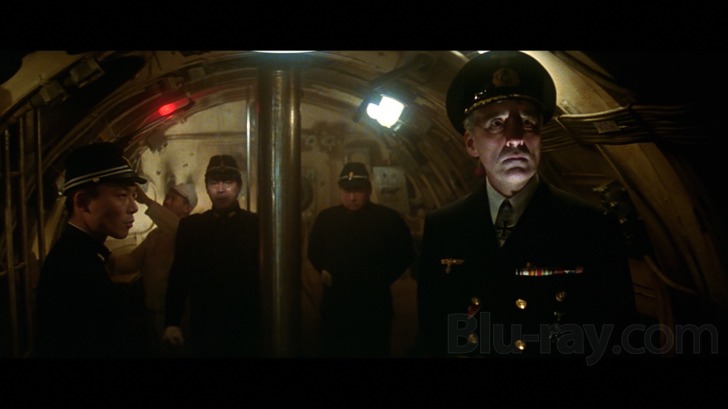
How does one score a cult classic like 1941? It's not great art, and it may not even be a great movie, but it marches to the beat of its own crazy drummer in a way that you can't help but admire, even if you decide not to follow it. Universal and Columbia didn't lose money on the project; they just didn't make the bundle they expected from a Steven Spielberg picture. Meanwhile, 1941 lives on. There's something about it, but you never know how people will react. My wife left our screening room after twenty minutes, while I laughed more at the Blu-ray than at any prior viewing. Decide for yourself.
Similar titles
Similar titles you might also like

Hot Shots! Part Deux
1993

Catch-22 4K
1970

How I Won the War
1967

Best Defense
1984

What Did You Do in the War, Daddy?
1966

The Secret War of Harry Frigg
1968

Hot Shots!
1991

Warfare 4K
2025

Mosquito Squadron
1969

To Be or Not to Be
1983

Strategic Air Command
1955

The Russians Are Coming, the Russians Are Coming
1966

Aces High
1976

Kelly's Heroes
1970

The Odd Angry Shot
1979

Age of Heroes
2011

Memphis Belle
1990

Went the Day Well?
48 Hours
1942

Hogan's Heroes: The Complete Series
1965-1971

Good Morning, Vietnam
25th Anniversary Edition
1987
